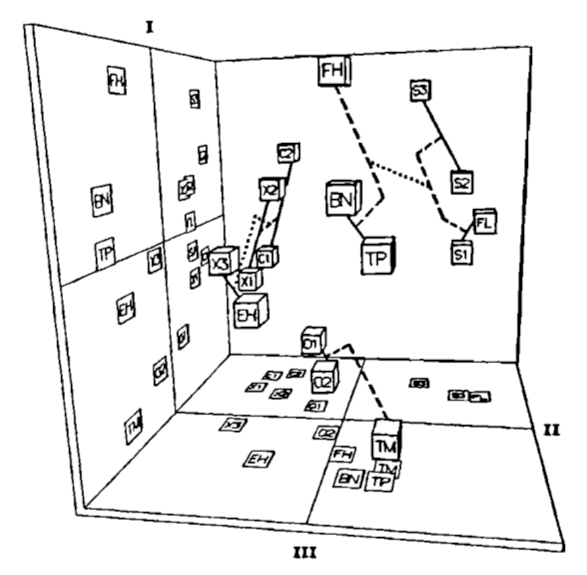
This is the timbre space from Grey (1977) "Multidimensional Perceptual Scaling of Musical Timbres." It was obtained by using multidimensional scaling to reduce the similarity judgments of subjects about stimulus tones with different timbres into a 3-dimensional space.
Roughly interpreted, Axis I characterizes spectral energy distribution, from narrow and low to broad and high; Axis II is related to the synchronicity with which harmonics enter and exit the tone together; Axis III also relates to the temporal dynamics of harmonics, characterizing something like presence or absence of low amplitude, high frequency overtones during the attack.
The stimuli were artificially synthesized in order to control for volume and duration. They were based on samples of actual instruments, however, in order to preserve realistic harmonic dynamics. Key: O1, O2: oboes; C1, C2: clarinets; X1, X2, X3: saxophones; EH: English horn; FH: French horn; S1, S2, S3: strings; TP: trumpet; TM: trombone; FL: flute; BN: bassoon.
Timbre Spaces I
In order to understand the psychology of timbre in a way which will be helpful for composers, we need to understand two things. First, what are the possible timbre experiences? Second, what do we have to manipulate in the world in order to control these experiences?
Unfortunately, it's difficult to know where to start on this question, as there is no intuitive "folk theory" of timbre. The timbres we are familiar with are usually described in terms of the traditional instrument which produced them: the sound of a violin vs. the sound of a tuba. Typically, when we try and give an explicit definition of timbre, we are forced to give it in negative terms:
Timbre is whatever feature of sounds distinguishes them other than pitch, volume, duration, and perceived spatial location.
This tells us what timbre isn't, but it doesn't tell us what timbre is.
One way to make progress on this question in psychology is through multidimensional scaling of similarity judgment data. Play subjects pairs of sounds with different timbres and ask them to rate how similar they are. This data can then be forced into a small number of dimensions (3 is easiest for visualization purposes) which preserve the similarity judgments as distances between the timbres.
Once we have a low-dimensional representation of the data, we can try and make psychophysical sense of the axes of our new "timbre space." Ideally, we'd like to find two analyses for each axis: one in psychological terms (what aspect of possible timbre experience does it represent?); one in physical terms (what sort of thing in the world do we change to affect that aspect of timbre experience?).